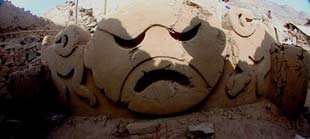Ancient calendar exposed me in Peru
Archaeologists have discovered a work considered a huge prehistoric calendar, made of carvings arranged in a circle, at the temple in Buena Vista, Peru.

Scary face image (Photo: yubanet)
The work, dating back to 2,200 BC, is the oldest of its kind known in the Americas. In Mexico there are similar buildings built by the Maya but only about 2,000 years old.
It can create spectacular views for viewers 4,000 years ago. Tall sculptures - made from mud mixed with hay and clay plaster - are painted bright yellow and red.
Robert Benfer, the project supervisor and anthropologist at the University of Missouri, said the temple and the sculpture seem to have astrological correlations to help people monitor their crops.
Events such as the setting sun and decaying points and solstice can create straight lines that connect points from the temple entrance, to the carvings and rooms.
In these rooms, archaeologists found many items used in religious ceremonies such as cotton seeds, guava, gourd, squash, beans and grass. In a hole in the center of the temple also contains shells, shells, crabs and fish bones. These items can be offered to the gods to pray to avoid supernatural phenomena.
The team found no signs of human sacrifice, but they found a mummy of women in fetal position. The Andea have a tradition of burying the dead in holy places.
The most bizarre object found in the temple is a large disc shaped with a scowling face when the sun goes down on June 21, the start of the harvest. However, researcher Hugo Ludeña at Federico Villarreal University said that the wrinkled face represents Pacha Mama, the earth mother becomes sad when the sun goes down.
- Unexpected code decoding on New Year's Day
- The Mayan calendar never mentioned the end of the world
- Why is the world in 2018 but this strange country is still 2011?
- New convenient calendar
- Flush rumors about the end of 2012
- Why is the solar calendar in February only 28 or 29 days?
- Dozens of tombs containing hundreds of 1,200-year-old ancient mummies were discovered in Peru
- October 1582 calendar with 10 days does not exist
- Ancient pet cemetery in Peru
- Algol spotted the secret of 'Devil Star' Algol blinked off randomly
- The reason for February is only 28 or 29 days
- The truth about the day
 Discovered an ancient centipede fossil 99 million years old
Discovered an ancient centipede fossil 99 million years old Discovered bat-like dinosaurs in China
Discovered bat-like dinosaurs in China Discovered a 200-year-old bronze cannon of the coast
Discovered a 200-year-old bronze cannon of the coast Discover 305 million-year-old spider fossils
Discover 305 million-year-old spider fossils